Exploring the Sheikh Zayed Grand Mosque: A Cultural Icon

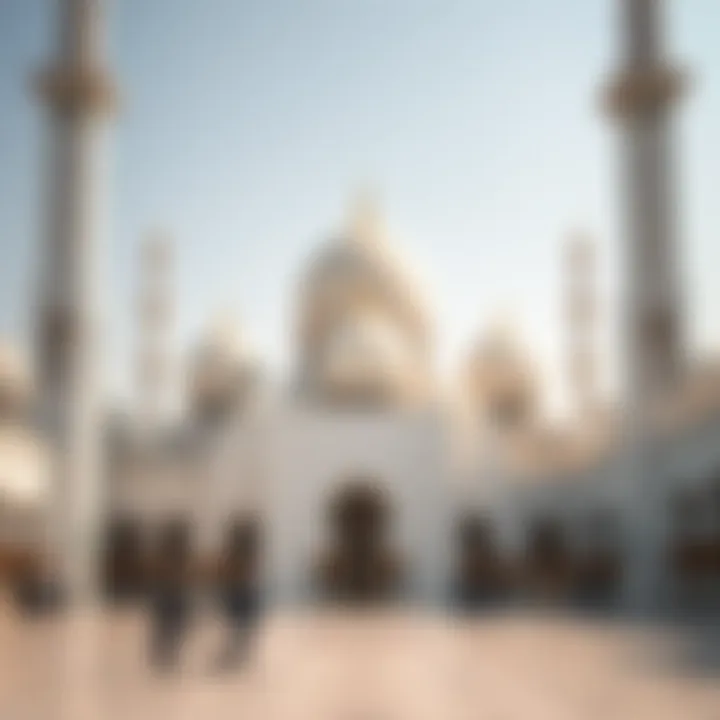
Intro
In the heart of Abu Dhabi, the Sheikh Zayed Grand Mosque stands as a remarkable blend of artistry and spirituality. It is not merely a place of worship; it serves as a cultural centerpiece that draws visitors from far and wide. This architectural masterpiece is a stunning representation of Islamic design, showcasing intricate details and breathtaking scale. For those intrigued by the confluence of culture, history, and architectural innovation, this mosque offers a wealth of insight.
From its conception in the late 20th century, the mosque has evolved into a significant landmark, embodying values of tolerance and understanding in a rapidly modernizing world. It reflects the UAE’s vision of unity and coexistence, aiming to forge connections among various cultures through its open doors and welcoming atmosphere. The mosque is not just about visual splendor; it's about the stories woven into every tile, every dome, every minaret.
Visitors often find themselves enchanted by the grandeur of white marble that gleams under the sun and the vast courtyard that invites reflection. The building itself, with its blend of various architectural influences, can be seen as a microcosm of global Islamic heritage, representing styles from across the Muslim world.
As we delve deeper into the architectural elements, historical context, and cultural significance of the Sheikh Zayed Grand Mosque, we will explore how it integrates with Dubai’s broader landscape. This understanding will not only enrich your visit but also illuminate the mosque's role as a beacon of spirituality and a testament to human endeavor.
Preamble to the Sheikh Zayed Grand Mosque
The Sheikh Zayed Grand Mosque, nestled in the heart of Abu Dhabi, serves not only as a place of worship but also as a symbol of cultural unity and architectural grandeur. This mosque stands as a remarkable bridge between tradition and modernity, showcasing the enduring values of Islam while welcoming people from all walks of life. As we delve into this foundational aspect of the mosque, it becomes clear that its significance extends far beyond its breathtaking aesthetics.
This article will explore multiple facets of the Sheikh Zayed Grand Mosque, providing insights into its architectural brilliance and the cultural heritage it embodies. Understanding the importance of this mosque requires a recognition of its grand scale and the artistic elements that speak volumes about Islamic culture. The vast white marble structure is adorned with intricate Islamic motifs and stunning calligraphy, embodying meticulous craftsmanship that attracts both local and international visitors.
Moreover, the mosque is not merely an architectural marvel; it plays a pivotal role in fostering community spirit and intercultural dialogue. The mosque invites those of different faiths and backgrounds to experience Islam, facilitating a broader understanding among various cultures. Importantly, the Sheikh Zayed Grand Mosque stands as a testament to the vision of Sheikh Zayed bin Sultan Al Nahyan, the founding father of the UAE, whose commitment to tolerance and coexistence is mirrored in the mosque’s very essence.
In this section, we will highlight some key elements of the mosque that will be examined throughout this article:
- The mosque's breathtaking architectural features, including its impressive domes and towering minarets.
- Historical context detailing the vision behind its construction and the symbolic significance tied to the design.
- The cultural influence of the mosque in promoting inclusivity and understanding among diverse communities.
Ultimately, the Sheikh Zayed Grand Mosque serves as a beacon of light, illustrating the values of respect, community, and cultural pride. As we proceed to explore its historical context, we will uncover the ambitious vision of its creator and how it came to life, enriching the cultural fabric of the UAE.
"The mosque is more than just a building; it’s a platform for dialogue, a place for connection, and a symbol of pride for the Emirati people."
Through a detailed examination, this article will enhance your understanding of the mosque’s remarkable contributions to both architecture and the global community.
Historical Context of the Mosque
The Sheikh Zayed Grand Mosque, situated in the heart of Abu Dhabi, not only stands as a stunning architectural delight but also embodies the cultural and historical ethos of the United Arab Emirates. The significance of the historical context behind this grand structure lies in its role as a nexus of faith, community, and national identity. Understanding the inception and evolution of the mosque provides insight into its immense cultural relevance and the visionary leadership that guided its creation.
The Vision of Sheikh Zayed
Sheikh Zayed bin Sultan Al Nahyan, the founding father of the UAE, envisioned a place that would epitomize unity and inclusivity. His aspiration was for the mosque to serve as a beacon of knowledge and friendship. This was not merely a construction project but an endeavor to create a spiritual landmark that would foster understanding among various cultures and religions. The mosque was to be a reflection of Sheikh Zayed's commitment to tolerance and coexistence, values that are deeply ingrained in the UAE’s social fabric. As he famously stated, "A mosque should not be a place where people fight or argue, but a place where they feel safe, at peace, and free."
Construction Timeline
The construction of the Sheikh Zayed Grand Mosque commenced in 1996 and stretched over more than a decade. This ambitious project was initiated with a meticulous planning phase, which involved not just architectural designs but also the selection of materials from around the globe. Early on, Sheikh Zayed emphasized the need for the mosque to incorporate both traditional Islamic architecture and modern influences, which resulted in a harmonious blend of styles.
The mosque's official opening took place in 2007, marking the culmination of years of labor and dedication. Throughout this period, the construction faced various challenges, including logistical complexities and the need to source high-quality materials such as white marble from Greece and Italy, as well as intricate Islamic calligraphy from local artisans. Following its completion, the mosque stood not only as a center for worship but as a canvas reflecting the artistic heritage of the UAE, drawing on influences from various Islamic cultures.
Inauguration and Early Years
Upon its inauguration, the Sheikh Zayed Grand Mosque swiftly became a prominent symbol of Abu Dhabi and the UAE as a whole. The early years following its completion were marked by a surge in visitors, both local and international. The mosque hosted various interfaith dialogues and cultural events, reinforcing Sheikh Zayed's original vision of fostering tolerance and understanding. These early years were crucial as they established the mosque not just as a place of worship, but also as a cultural landmark, welcoming people from all walks of life to experience its beauty and serenity. The mosque has since positioned itself as a must-visit destination, drawing millions who seek to marvel at its intricacy and grandeur.
In summary, the historical context of the Sheikh Zayed Grand Mosque encapsulates the dreams of its founder and the aspirations of a nation, reflecting not only its architectural prowess but also its pivotal role in promoting cultural cohesion. As Abu Dhabi continues to evolve, this mosque serves as a steadfast reminder of the values of unity, peace, and respect that are foundational to the UAE's identity.
Architectural Design Features
The architectural design of the Sheikh Zayed Grand Mosque is a fundamental aspect that greatly contributes to its status as an architectural marvel and cultural beacon. This mosque, completed in 2007, stands as an example of how traditional design can harmonize with modern materials and techniques. This section will explore the various features that define its architectural essence, including the influence of Islamic architecture, the materials used in its construction, and the landscaping that surrounds it.
Influence of Islamic Architecture
Islamic architecture is not merely a style but a reflection of a rich cultural heritage. The Sheikh Zayed Grand Mosque draws heavily from various traditional Islamic architectural elements, showcasing the depth and diversity of the Islamic world.
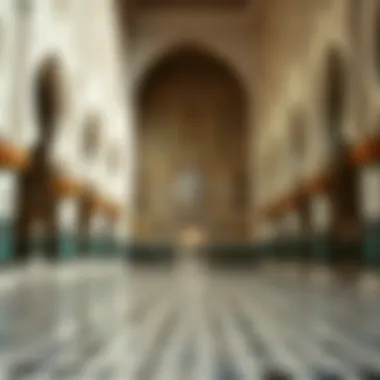
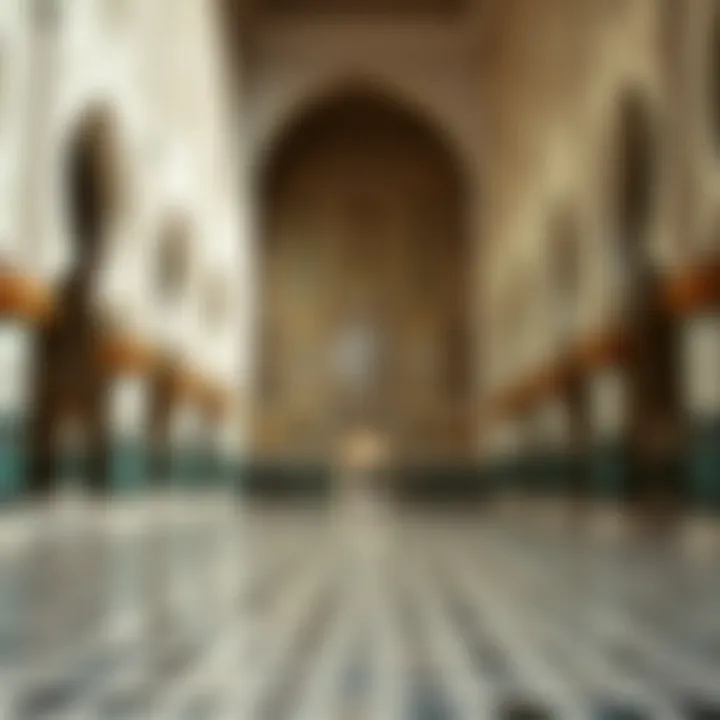
- Moorish, Ottoman, and Mughal Influences: The mosque's design beautifully marries these three styles, evident in its intricate patterns and domed ceilings. The stunning white marble, for instance, echoes the majesty of the Taj Mahal, while the geometric arabesques mimic patterns found in Spanish mosques.
- Courtyards and Prayer Halls: Open-air courtyards provide a breath of fresh air, allowing natural light to seep through, promoting a sense of tranquility and reflection. This design choice is not just aesthetic but functional, catering to the needs of worshippers and visitors.
The mosque is more than a place of prayer; it’s also a masterpiece that narrates the story of Islamic civilization through architecture, drawing visitors from all over the globe.
Materials and Techniques
The choice of materials and construction techniques used in the mosque is as fascinating as the architecture itself. They reflect a blend of tradition and innovation, showcasing the skills of craftsmen and engineers alike.
- Marble: The mosque is primarily clad in white marble sourced from several countries, including Italy and Greece. This choice not only adds to its beauty but also symbolizes purity and peace.
- Handcrafted Details: Every nook and cranny of the mosque is a testament to skilled craftsmanship. Master artisans flocked from various countries to partake in the creation of the mosque's intricate elements, from the elaborate chandeliers to the detailed carvings on the walls.
- Modern Techniques: While steeped in tradition, the mosque also employs modern techniques to ensure sustainability. Advanced engineering ensures that the building can withstand local climate conditions and offers an efficient cooling system, demonstrating a forward-thinking approach ingrained in its very foundations.
Landscaping and Surroundings
The landscaping of the Sheikh Zayed Grand Mosque complements its architectural grandeur, creating a serene oasis that enhances the visitor experience.
- Reflective Pools: The mosque is bordered by stunning reflective pools that amplify its beauty, offering a celestial view that changes with the time of day. This feature adds depth to the structure and encourages introspection among visitors.
- Gardens and Green Spaces: The surrounding gardens are meticulously designed, incorporating native flora that flourish in the desert climate. These green spaces provide a calming backdrop, where visitors can pause and appreciate the beauty and tranquility of their surroundings.
- Lighting: At night, the mosque comes alive with strategic lighting that highlights its architectural features against the backdrop of the night sky. The interplay of light and shadows enhances its ethereal beauty, inviting people to reflect on the mosque’s significance long after visiting.
"The richness of the Sheikh Zayed Grand Mosque lies not just in its architectural wonder, but in the stories and cultural dialogues it fosters across borders."
In sum, the architectural design features of the Sheikh Zayed Grand Mosque play a crucial role in its identity. By merging Islamic principles with modern practices, utilizing exquisite materials, and carefully crafting its surroundings, the mosque stands as a symbol of both faith and artistry in a rapidly evolving world.
The Dome and Minarets
The architectural centerpiece of the Sheikh Zayed Grand Mosque is undoubtedly its magnificent dome and soaring minarets. These elements not only enhance the visual appeal of this grand structure but also hold immense cultural and religious significance. In this section, we will explore the deeper meanings of these elements while shedding light on their remarkable designs and the benefits they bring to both worshippers and visitors alike.
Symbolic Significance of the Dome
The dome of the Sheikh Zayed Grand Mosque is an impressive feature, standing at a height of 85 meters. Symbolically, it represents the heavens and is often viewed as a gateway between the earthly and the divine. The round shape mirrors the Islamic concept of unity and wholeness, reminding worshippers of the importance of community and harmony.
In a place where spirituality meets architecture, the dome acts as a focal point that draws the eyes and hearts of its observers. The intricate mosaics and decorative elements found both inside and out enrich the visual experience and echo the celestial qualities of Islamic traditions.
"The dome stands not just as a structure, but as a bridge to the divine, encapsulating the soul's aspiration towards the heavens."
The significance of the dome extends beyond aesthetics. It encourages a sense of awe and reverence among the mosque's visitors, fostering a deeper understanding of Islamic beliefs and practices. Furthermore, during prayers, the acoustics of the dome amplify the voice of the imam, creating a spiritually resonant experience that aligns the community in worship.
Height and Design of the Minarets
Adding to the mosque's grandeur, the four minarets are strategically positioned at the corners of the structure, reaching a height of 107 meters. They serve not only as stunning architectural features but also as functional elements that support the mosque's role in the community. Each minaret is adorned with delicate calligraphy and intricate designs that reflect traditional Islamic art.
The minarets are essential for the adhan, the Islamic call to prayer, which can be heard across a substantial radius. This call is a daily reminder of faith, instilling a sense of belonging among community members and inviting them to come together in prayer. The high placement of the minarets serves a practical purpose, ensuring that the adhan reaches as many people as possible, transcending the immediate vicinity.
In terms of design, the features of these minarets contribute significantly to the overall harmony of the mosque’s façade. Their slender forms draw the eye upwards, creating an impression of height and grandeur that resonates well with the large dome. The minarets, with their intricate marble work and ornamental details, symbolize the unity and strength of Islamic artistry.
Thus, the dome and minarets of the Sheikh Zayed Grand Mosque are far more than architectural achievements; they embody deep cultural traditions and foster community ties catalyzing the essence of Islamic practices. The interplay of these elements stands as a reminder of the beauty that lies in faith, architecture, and shared spiritual journeys.
Interior Design Elements
The interior design of the Sheikh Zayed Grand Mosque is a vivid tapestry that intertwines tradition and modernity. It serves not only as an aesthetic delight but also plays a pivotal role in enhancing the spiritual experience of worshippers and visitors alike. In a place where tranquility is sought, the elements within the mosque work harmoniously to create an environment conducive to reflection and prayer.
Prayer Hall Aesthetics
At the heart of the mosque lies the prayer hall, an oasis of serenity decorated with intricate artistic elements that evoke a sense of wonder. The grand and vast prayer hall can accommodate thousands of worshippers and features high ceilings adorned with stunning mosaics and delicate floral patterns inspired by the natural world.
The light that filters in through the large windows softens the atmosphere, creating an inviting glow that encourages contemplation. The play of light and shadow adds depth, while several majestic chandeliers crafted from crystal provide luxurious accents that catch the eye and inspire awe.
Key Features of the Prayer Hall:
- Spaciousness: The main prayer area stretches wide, giving ample room for congregational worship.
- Acoustics: Thoughtful design considerations were made to enhance sound quality, allowing for clear hearing during prayers and sermons.
- Artistic Details: Floral motifs panelled elegantly against a backdrop of pure white marble, make the interior feel cohesive and grounded in Islamic tradition.
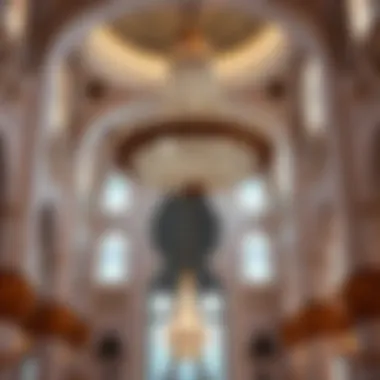
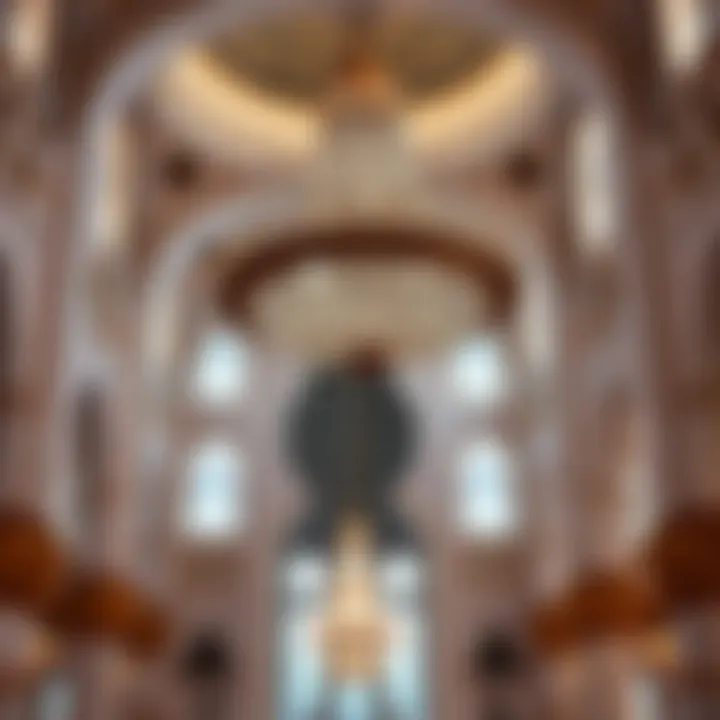
Intricate Carpets and Chandeliers
Delving deeper into the prayer hall’s allure, one cannot overlook the splendid carpets and chandeliers that adorn this sacred space. The carpets, made by skilled artisans, not only cover the floor but embody craftsmanship that reflects the rich heritage of Islamic art.
Taking nearly two years to complete, the carpets are designed with a complex pattern that repeats the themes of nature — a nod to the Quranic verses that speak to the beauty of the created world. Each piece serves both beauty and functionality, providing comfort to those who kneel in prayer.
On the ceiling, the chandeliers form a breathtaking spectacle. One of the largest in the world, the centerpiece chandelier weighs an impressive 12 tons and is an epitome of luxury, made from thousands of Swarovski crystals. Together, the carpets and chandeliers create a sense of continuity, leading the eye upward and integrating the visual experience of the prayer hall.
"The interior of the Sheikh Zayed Grand Mosque combines opulence with spirituality, a reflection of the mosque's vision to be a beacon of peace and culture."
In summary, the interior design elements are carefully curated to elevate the experience of all who enter. The artful blend of carpets and chandeliers, paired with the aesthetics of the prayer hall, makes the mosque a noteworthy example of how architecture can reflect cultural values while also serving a functional purpose.
Cultural and Religious Significance
The Sheikh Zayed Grand Mosque is not just a remarkable structure; it serves as a vital cultural and religious centerpiece within the United Arab Emirates. It reflects the rich heritage and values of a nation keen on promoting understanding and unity among its populace. This section explores its significance in fostering spiritual growth, community engagement, and cross-cultural dialogue.
A Space for Worship and Community
This mosque is a sanctuary for thousands, allowing people to come together and engage in worship. It offers a serene atmosphere where individuals can reflect, pray, and strengthen their connection with faith. Each Friday, a special communal prayer attracts locals and expatriates alike, illustrating the unifying power of this sacred site.
The mosque is also equipped to accommodate a significant number of worshippers, with a capacity of over 40,000. This characteristic emphasizes its role as a place where people from diverse backgrounds can gather to share in devotion. The vibrant community surrounding the mosque enhances the experience, as it hosts various cultural events and educational programs.
Moreover, the mosque's architecture brings a sense of belonging, with its intricate designs symbolizing unity. The mosaics, marble work, and calligraphy narrate stories of Islamic culture, inviting visitors into a deeper understanding of the faith and its practices.
Role in Interfaith Dialogue
Beyond serving as a religious venue, the Sheikh Zayed Grand Mosque is a beacon for interfaith dialogue. It stands as a testament to the vision of tolerance that Sheikh Zayed bin Sultan Al Nahyan, the founding father of the UAE, championed. By hosting interfaith gatherings, the mosque breaks down barriers and fosters respect for different beliefs.
The mosque has played host to various events that encourage conversations across faiths. For instance, it opened its doors for visitors of all backgrounds, providing tours that emphasize the importance of understanding and cohabitation in a multicultural society. These tours often include insights into Islamic teachings, showcasing the mosque not merely as a place of worship, but as a ground for enriching dialogue among religions.
"In this place, we seek common ground and a celebration of humanity’s shared values,” a representative of the mosque stated during an interfaith panel.
Through its commitment to openness, the Sheikh Zayed Grand Mosque challenges stereotypes and promotes a culture of peace and understanding. Such initiatives ensure that the mosque remains relevant in a rapidly changing social landscape.
In summary, the cultural and religious significance of the Sheikh Zayed Grand Mosque transcends its architectural beauty. It acts as a hub for community worship, an advocate for interfaith understanding, and a symbolic representation of unity in diversity. This institution exemplifies how spiritual and communal life can intertwine within an architectural masterpiece.
Visitor Experience and Guidelines
Visiting the Sheikh Zayed Grand Mosque isn’t just about observing a magnificent structure; it's a journey that opens the door to understanding cultural richness and traditional values. As a cultural beacon in the UAE, the mosque has meticulously crafted guidelines that ensure visitors experience its beauty and significance while respecting its sanctity. This section will explore essential aspects of the visitor experience, helping guests get the most out of their visit, be it through structured tours, understanding admission processes, or abiding by decorum expected within its walls.
Access and Admission Details
Gaining entry into the Sheikh Zayed Grand Mosque is a seamless process, designed to welcome visitors from all walks of life. The mosque is open to the public, with no admission fees, making it accessible to tourists and residents alike.
- Location: Situated in Abu Dhabi, just a short drive from the city center, the mosque is well-connected by public transport options such as taxis and buses.
- Operational Hours: Typically, the mosque is open daily, although the hours can vary according to religious activities. It’s advisable for visitors to check the official website for the latest information before planning their trip.
- Security Checks: Upon arrival, visitors will undergo a security screening similar to those found in airports. Being prepared for this helps avoid delays and ensures smoother entry.
Dress Code: Maintaining respect for the mosque’s sacred atmosphere is paramount. Visitors must adhere to specific dress guidelines.
- Women: Should cover their hair with a scarf and wear loose-fitting clothing that covers arms and legs. It’s often recommended to wear abaya, which is available for rent or borrowing at the mosque.
- Men: Are expected to wear long trousers and avoid shorts.
Following these guidelines not only enhances the experience but also honors the cultural significance of this grand place of worship.
Guided Tours and Educational Programs
For those interested in delving deeper into the grandeur of the Sheikh Zayed Grand Mosque, guided tours and educational programs provide a rich, informative layer to the visit.

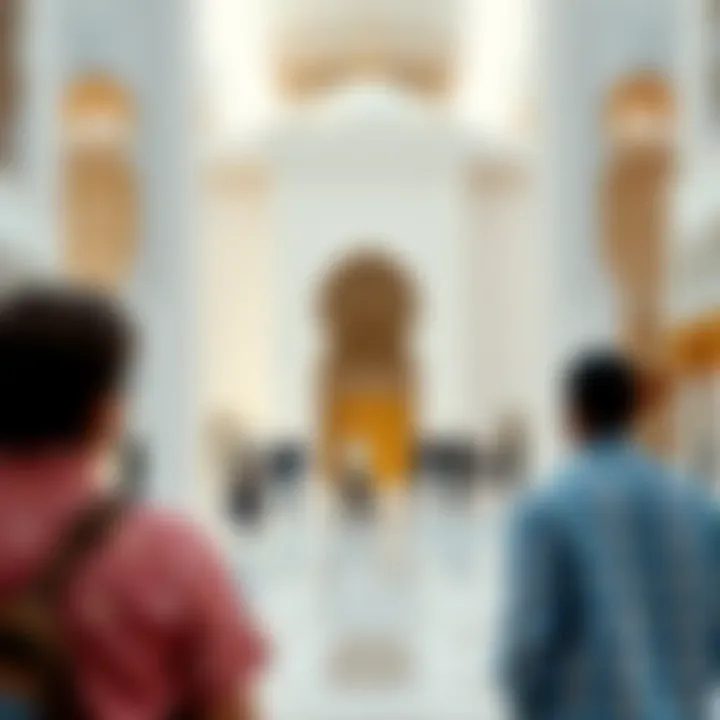
Guided Tours: The mosque offers guided tours several times a day conducted by knowledgeable guides who speak various languages. These tours typically last about 60-90 minutes and cover the following:
- Architectural Highlights: A detailed exploration of the mosque's architectural elements, including the beautiful domes and ornate gardens.
- Cultural Insights: Learn about Islam’s teachings, the mosque’s role in the community, and the vision of Sheikh Zayed.
- Audience Interaction: Visitors can ask questions and engage in discussions, providing a personal touch to the experience that enriches understanding.
Educational Programs: Apart from tours, the mosque often hosts workshops and lectures aimed at fostering intercultural dialogue and education about Islamic art, architecture, and religion. These programs might include:
- Art Workshops: Hands-on sessions that allow participants to explore Islamic art techniques.
- Discussion Panels: Opportunities to engage with religious scholars and cultural ambassadors, enhancing both knowledge and appreciation of the mosque’s significance.
"The beauty of the mosque mirrors the beauty of unity and tolerance that it stands for. A visit here isn't just a tour; it's a step towards understanding harmony in diversity."
For more details on planning a visit, check the official Sheikh Zayed Grand Mosque website.
Impact on Tourism in Dubai
The Sheikh Zayed Grand Mosque isn’t just a religious site; it’s a phenomenal influence on tourism in Dubai and even the wider UAE. As a cultural beacon, the mosque draws millions of international visitors every year. This surge in tourism brings along a myriad of benefits — from economic boosts to cultural exchanges — allowing for a deeper understanding of the UAE’s rich heritage.
As this architectural marvel stands tall, it invites travelers from across the globe, showcasing the amazing fusion of Islamic architecture and modern art. The majestic nature of its design, with its intricate details, visually captures the heart and minds of the visitors.
Attracting International Visitors
One of the most significant aspects of the Sheikh Zayed Grand Mosque is its ability to attract international visitors. This site is often featured in travel blogs, documentaries, and social media platforms as a must-see destination when visiting Dubai. Historically, other attractions are important, but the mosque resonates on a larger scale due to its cultural and spiritual significance.
- Aesthetic Appeal: The mosque's captivating beauty entices tourists looking for stunning visual experiences to share on their own platforms.
- Cultural Exchange: Visitors often engage with the local heritage, opening up channels for understanding and respect among different cultures.
- Educational Value: The site provides enriching educational opportunities, with guided tours offering insights into Islamic traditions and architectural techniques that appeal to history buffs and architecture enthusiasts.
Contribution to Local Economy
The impact of the mosque on Dubai’s local economy cannot be overstated. By drawing in tourists, it stimulates a range of local businesses, servicing not only the mosque but the surrounding areas as well. Here are some ways the mosque contributes:
- Hospitality Sector Boost: Hotels and restaurants see increased occupancy rates and customer traffic, significantly benefiting from the influx of tourists who often spend on food, lodging, and other services.
- Retail Growth: Souvenir shops and cultural centers thrive, reflecting the interest in the local craftsmanship and aesthetic associated with the mosque.
- Job Creation: Increased tourism translates to more jobs across various sectors, including hospitality, transport, and retail. This means that more opportunities are created within the community, thereby reducing unemployment.
The influx of visitors to the Sheikh Zayed Grand Mosque establishes it not just as an exclusive attraction, but a vital part of Dubai’s tourism landscape. As the local and international communities connect through the beauty of this architectural marvel, they enrich both the cultural fabric of the UAE and its economy.
"Tourism is not just about seeing sights; it’s about embracing cultures and fostering connections. The Sheikh Zayed Grand Mosque encapsulates this spirit perfectly, bridging gaps and fostering mutual respect."
This symbiotic relationship between the mosque and the tourism sector showcases that sustainable tourism can play a crucial role in cultural preservation while benefiting the modern economy.
Future Prospects and Developments
The Sheikh Zayed Grand Mosque continues to shine as a beacon of modern Islamic architecture and cultural relevance. In light of its growing significance, understanding the future prospects and developments surrounding it is essential. This section delves into crucial aspects, including conservation efforts and planned cultural events, that illustrate the mosque's commitment to preserving heritage while fostering community engagement.
Conservation and Maintenance Efforts
Maintaining the grandeur of the Sheikh Zayed Grand Mosque isn't a trivial endeavor. The mosque, with its intricate designs and vast expanse, demands regular upkeep to ensure its structures withstand the elements and the passage of time.
One of the primary focuses on conservation is monitoring the building materials. The mosque is constructed with a variety of features ranging from marble to semi-precious stones and intricate mosaics. Keeping these materials in pristine condition is vital. There are specialized teams trained in cleaning techniques that safeguard the delicate surfaces without causing damage.
Additionally, several technology tools are employed to assess wear and tear before they become visible to the naked eye. For instance, high-resolution imaging helps in tracking small cracks or stains that might escalate if not addressed promptly. This proactive approach not only prolongs the life of the mosque but also enhances the visitor experience by maintaining its breathtaking beauty.
A commitment to sustainability is also visible in the mosque's maintenance policies. Solar panels and energy-efficient systems are essential parts of the mosque's infrastructure, ensuring that the energy consumed while preserving this architectural wonder is minimized.
Closure
The Sheikh Zayed Grand Mosque holds a prestigious place not only within the architectural landscape of Abu Dhabi but also in the hearts of people around the world. Its distinctive blend of traditional Islamic design and modern construction techniques offers an exceptional example of how cultural heritage can harmonize with contemporary aspirations. This juxtaposition serves as a mirror reflecting the UAE’s own journey toward balancing tradition with modernity.
The mosque is far more than just an aesthetically pleasing structure; it operates as a dynamic center for cultural exchange and interfaith dialogue. By opening its doors to visitors from various backgrounds, it fosters a deeper understanding of Islamic teachings and traditions, enriching the experience for both Muslims and non-Muslims alike. The essence of unity that the mosque embodies resonates strongly with its visitors, making it a beacon of hope and collaboration in today's often fragmented world.
When considering the ramifications of institutions like the Sheikh Zayed Grand Mosque, several key points emerge:
- Cultural Significance: The mosque underlines the importance of preserving cultural identity while adapting to modern changes.
- Tourism Impact: It serves as a critical driver for tourism in the UAE, attracting millions and contributing substantially to the local economy.
- Interfaith Engagement: By encouraging respectful dialogue among diverse religious and cultural groups, it enhances social cohesion.
In summary, the Sheikh Zayed Grand Mosque is not just an architectural marvel; it is a vibrant cultural hub with far-reaching implications in various realms. Its role in advancing community spirit, promoting understanding, and bolstering economic activity highlights the multifaceted benefits of this iconic landmark. As visitors and Emiratis alike gather in this grand setting, they partake in a living expression of unity, reverence, and peace. The mosque stands as a testament to the values of openness and dialogue, vital for navigating an increasingly interconnected yet complex world.
"Architecture is a visual art, and the buildings speak for themselves."
– Julia Morgan.















